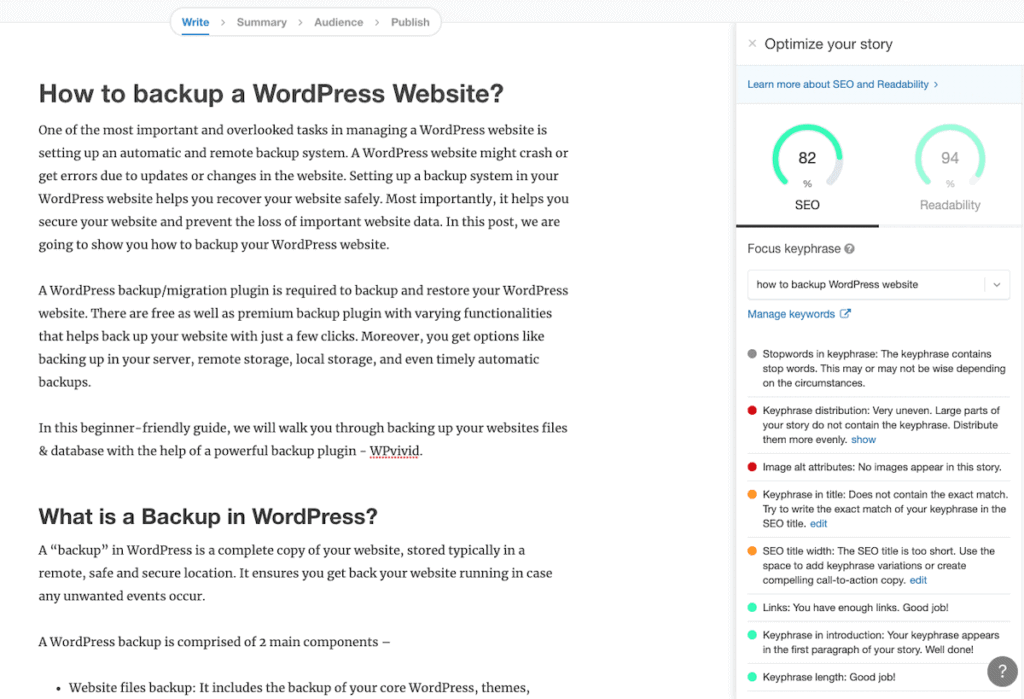The tools and plugins recommend in the site are the ones we use, have tried or tested ourselves and recommend to our readers. Marketing With WP is supported by readers like yourself. If you take an action (such as a purchase) we might earn an affiliate revenue at no extra cost to you.
Top Google Ranking Factors – Learn how to rank higher on Google

Google is constantly changing the algorithm to fine-tune how it ranks websites. It is now more important than ever to optimize your website for SEO (search engine optimization) if you want to increase your visibility on Google. This blog will give you an idea of the top-ranking factors for SEO.
If you did not know already, most of the purchasing decisions online start with a Google search.
You can leverage Google to show your product or services in front of your potential customers with Search Engine Optimization. Moreover, ranking higher on Google serves many other benefits like quality website traffic, brand visibility, credibility, conversion, etc.
Although Google’s exact ranking factors are not written on the wall, Google does provide a set of Guidelines to influence results that will help your content rank higher in search results.
In this post, we will cover a list of top-ranking factors we believe is essential to achieve a higher SERP ranking on Google.

What Are Ranking Factors?
First, let us understand how search engines like Google work.
Fun Fact: If you post a content on your website and search for it on Google immediately, it won’t show because the content has not been crawled nor indexed by Google.
Google has a large number of bots constantly crawling the internet and collecting data. The crawled information is then stored in its database (index). And when users enter a search term, Google pulls the websites containing relevant results from its index and displays them on SERPs.
You might have noticed that Google comes up with a large number of results for your search terms.

Among them, the most relevant results display on the first result page to answer the users’ search query. But how?
It’s done with Google’s search algorithm. Google has developed a powerful algorithm consisting of various factors to sort and filter results from its index and rank them in SERPs. Those factors are called the ranking factors.
The ranking factors are a list of important metrics Google checks to determine whether the web page is trustable and whether it provides the answer users are looking for. If yes, then the web page appears higher.
While the exact algorithm and the ranking factors have been kept secret, some have been made public by Google. Also, some of them have been found out by doing various tests.
Google claims that there are over 200 ranking factors like relevance, authority, freshness, quality, speed, and so on.
As a website owner, your task is to create valuable content for users and to align your website with those ranking factors to show up more in SERPs. This process is also called Search Engine Optimization (SEO).
At the end of the day what you have to understand is, Google wants to reward the best content with the highest-ranking position. Google wants users’ queries to be satisfied with the best content since users will keep coming back to using Google. More users, more queries, and more content mean more revenue for Google through its advertising platform.
Types of Ranking Factors
The search engines take into account different kinds of ranking factors that are associated with relevance, domain trust, credibility, user experience, etc.
For the general classification, the ranking factors have been classified into 3 types. They are –
- Technical ranking factors – the factors associated with the website’s performance, user experience, and ease of navigating your overall website.
- On-page ranking factors – the content elements that you can tune inside your website for improving content quality.
- Off-page ranking factors– the external factors that affect the authority of your website
Technical Ranking Factors
The technical factors are the aspects of your website that help Google crawl and index better. With better crawling and indexing, you’ll have a better chance of ranking for relevant search queries.
Also, the technical ranking factors handle managing and optimizing websites to provide better website usability and user experience.
Along with great value, Google looks for websites that help users with a great browsing experience while ranking. So, improving the technical aspects like performance, security, use of optimized codes, etc. helps.
Here are some of the important technical ranking factors for your website.
1. Page speed
Having a fast website is something you must care about if you want to win traffic and customers. A study on page speed shows that about 53% of users on mobile leave a website if it takes more than 3 seconds to load. It’s even worse if it takes more.
Website speed is an important metric that not only boosts your SEO ranking but also provides users a great experience.
Here are some ways to attain good website speed –
- Hosting service – Purchase a better hosting service with appropriate bandwidth and storage. Services like Hostinger and Kinsta offer good website speed for all types of websites at better deals.
- Use clean codes – Having clean codes, your website will load faster. You can also optimize your codes with various measures like JS & CSS minification. Here is a list of popular themes that are built for SEO.
- Optimize images – Images are an important part of your website and takes some chunky space. Thus, you should compress your images before uploading them to the website.
- Reduce website redirects – If a URL redirects users from one domain to another, it takes some extra time to load. So, you should avoid website redirecting as far as possible.
- Caching – Caching means saving a temporary copy of your web page on the server so dynamic websites would load faster while clicking. So, use the caching features available in web hosting services.
To test your website speed, you can use tools like Google PageSpeed Insights, GTmetrix, etc.

2. Mobile-Friendliness
Traditionally, websites were meant for desktops and laptops. And when mobile phones first came out, browsing websites on mobile phones was possible but with great difficulties.
Today – it is quite the opposite.
Here’s a fact – over 50% of website traffic comes from mobile in 2021.
With the wide use of mobile phones, it’s been mandatory for business owners to have a mobile-friendly website. In fact, Google has announced Mobile-first indexing in 2019, giving more priority to websites having a mobile version.
Moreover, websites today need to be responsive. Responsiveness means the property of a website to fit well on all the screens of all sizes and devices.

Creating a responsive website is not a hassle anymore. Most of the website builders and CMSes offer responsive inbuilt core and their attachments as well.
Google offers Mobile-Friendly Test Tool to check if your site is mobile-friendly.
3. Internal Links
You must have encountered a link while visiting websites, reading blog posts, or even on Facebook and Twitter feeds.
Links are pointers on a web page that directs users to a different web page.
We have talked earlier that Google bots go through every link they find (unless configured otherwise).
Website admins can interlink pages on their website for Google bots and spiders to crawl the other relevant pages inside the website. The linking of web pages inside the same website (domain) is cited as ‘internal linking.

Internal linking not only helps Google crawl and index your website better but also lets users discover new pages and information.
Also, it keeps the audience for a longer time on your website, which is a very positive SEO signal.
So, take every opportunity to link every other page on your website so that it forms a web of links.
Note: Also, ‘external links’ are the exact opposite of internal links – it’s the link from one domain to another one. Mentioning other domains on your website have no significant growth on your SEO rankings, but Google notices your participation and engagement on the internet. Nonetheless, it helps improve connections with other websites and businesses.
4. Site Security
Security is a major concern for all websites that marketers and businesses have to care about.
Having an unsecured website is always a point of attack for hackers. With that, it causes website data loss, users’ data theft, as well as it disrupts your website’s reputation. Also, it can be slightly helpful for having website SEO rankings.
There are many ways to secure a website – creating website backups, enforcing strong passwords, using a firewall, etc. Among all, having an HTTPS (Hypertext Transfer Protocol Secured) website is what Google looks for the most.
HTTPS improves website security by ensuring encrypted data transmission from web servers to visitors’ devices.
Spotting an HTTPS-enabled website is easy – just check the URL address bar.

To enable HTTPS on your website, you should install an SSL certificate on your website. You can purchase it from different domains and hosting services. Also, major service providers offer SSL for free on their subscription package.
On-page Ranking Factors
On-page SEO is the practice of optimizing web pages for specific keywords to improve visibility, rankings, and traffic from Search Engine Results Pages (SERPS). It includes making changes to elements such as Headings, Meta Title and Description, Images, and on-page contents.

Some of the technical factors might have overlapped with the on-page factors. This is because the technical factors are also the tunable parts on your website, but focuses on technical parts wholly.
Some marketers even argue that the technical ranking factors are the subset of on-page ranking factors.
Following are some of the most important on-page ranking factors.
5. Content Quality
There’s no doubt that content is the king. Google’s algorithm change and evolve all the time. But, what it constantly gives priority is reaching users with the best content on the internet.
So, the primary focus of website owners and marketers should be to create quality content that satisfies the search intent.
The content that provides valuable, relevant, in-depth, and readable information to the users would have higher ranking chances on search engines.

Also, Google has keen eyes for original content – it’s constantly looking for unique and fresh information on the web. So, deliver content with original research and in your own words. Regardless of the platform you’re publishing on, be sure to provide unique content for the users.
Another benefit of qualitative content is that it not only ranks on the organic listing but also as a featured snippet. The featured snippet is a short and direct answer to the user’s search query appearing above the usual organic search result.
Here’s more on achieving featured snippets on Google.
Also, make sure that your content is free of plagiarism as this will negatively affect your SEO rankings.
6. Keywords
Keywords are simply the words that users type in to find information on Google.

Content optimized for a specific keyword could do well in search for that targeted keyword.
So, you should spend time understanding the keyword and the intent behind a search term, and create content best answering the question. Check out our complete guide on SEO keywords, understanding them and how to drive more traffic with keyword research.
Google itself is the best place to find keyword ideas. Just type something on your niche and it auto completes with the popular queries users search for.
Here’s an example.

You can take ideas and create content based on such keyword suggestions.
Besides, other popular keyword research tools are Ubersuggest, Google Keyword Planner, Ahrefs, etc.
Also, mentioning the keywords multiple times on your post makes it looks relevant, thus improves SEO rankings. But don’t do it too often as Google can penalize you for trying to bend the SEO guidelines to your advantage.
Instead, you can use LSI (Latent Semantic Indexing) keywords on your content – the words related to the main keyword. It gives Google more detailed information on what the page content is about. And, thus it displays the content for a relevant search term.
7. Title Tag, Meta Description, & URL
The SEO title, meta description, and URL are what users see about your web page on the SERPs.

Firstly, you’d want to insert the focus keywords on the SEO title, and also on the main headings on the content if possible. This will give Google a sense of relevance and understanding of the content in-depth.
Also, you can include the keywords in your meta description and the URL. It’s believed that they are not the prominent factors for boosting your ranking. But still, they’ll surely add value to your web page on SERP, enticing users to click it.
Besides, make sure that you use simple, easy-to-read URLs. Previously, the URLs used to look like a series of characters that made no sense to the users. Also, this doesn’t give the search engines any information about the page or post.
While a structured URL with readable words makes it much easier for Google as well as users to understand.
8. Image Alt Tags
The image alternative (alt) text tag is descriptive text that explains what the image is about.
When an image doesn’t load on a web page, its alt text is what appears in place of the image. This gives the user an idea about the image when images fail to load.
Now, Google also takes the image alt tag as a ranking signal. Since Google can’t read images, it uses alt text to understand what it’s portraying.
Every web images have a place to add alt text. So, be sure to add appropriate, relevant alt texts for all images on your web page.

This will boost the images’ ranking on related image searches. With that, you’ll have a higher chance of getting website visits from the image clicks.
Check out our complete On-Page SEO techniques to rank contents higher in Search Engines
Off-page Ranking Factors
Off-page ranking factors are the entities outside a website that improves SEO ranking on SERPs.
The off-page factors are not in control of a website owner. They work as other brands, businesses, and websites mention your website or business.
Your mentions in others’ websites, social media, etc. let Google understand your website is authoritative. And, thus Google prioritizes your website over others.
An important off-page factor to focus on is the backlink which we’re going to talk about here.
9. Backlinks
Who do you believe is more trustworthy? An individual who has 10 other people vouching for them or another individual who has no one vouching for them?
That’s literally the logic Google uses with backlinks.
A backlink is an external link from the contents of another website pointing to content on your website.

The backlinks indicate that your website is providing some value, it’s trustworthy, hence it can be cited. Since other websites are pointing their audiences to yours; it means that your website must be useful to their audience.
More backlinks are of course always good for SEO, but Google also put more emphasis on websites that get quality backlink.
However, all backlinks don’t have the same value.
Your website might get links from all sorts of websites. But, the links from authoritative websites, preferably of the same niche will have more impression.
For example, if you own a news website, then getting backlinks from BBC or CNN (More trustworthy and authoritative) will have more value.
Backlink building strategies
The most important way to earn backlinks is creating linkable assets – qualitative content that other websites share naturally. If your website provides value, then you’ll certainly get backlinks.
Some websites buy backlinks – pay others to link to your website. That looks unnatural and comes under black hat SEO. Thus, we strongly discourage such link building.
Now, let’s see some backlink-building strategies.
i. Guest Posting
As the name suggests, guest posting means writing posts for other blogs as a guest.
You can reach different blogs on your niche and propose to create some content for free. And, in exchange, you can add some links back to your website.
It’s a 2-way benefit for you and the company you’re writing for. So, the companies would likely agree.
Here are some tips for guest posting.
- Create a list of websites you want to reach out to.
- Select the websites with higher domain value than yours.
- Connect to the websites through professional email copy and mention your motto clearly.
- Don’t add too many backlinks as it would look unnatural.
ii. Broken link building
Many websites have links that don’t work. These links are called broken links.
Now, what you can do is search for broken links on websites that you want backlinks from. Then, reach out to the website owner and request for replacing the busted link with your working link.
To check the broken links, you can find various online tools like Online Broken Link Checker, Ahrefs Broken Link Checker, etc.
Conclusion
Google has tons of factors associated to rank a website. Here, we have narrowed it down to a list of 9 things you can work on improving your website SEO and ranking.
Also, we hope that you can do well in appearing in search results applying these strategies we talked about here.
Here’s a fact – Google’s algorithm is constantly evolving with updates in the ranking factors. But, the key takeaway here is focusing on providing qualitative and valuable content to the users. Work on providing a better experience to the users; Google will automatically take your website as trustable and authoritative.
Check out our other articles on Search Engine Optimization to improve your website’s ranking and performance on search engine.



